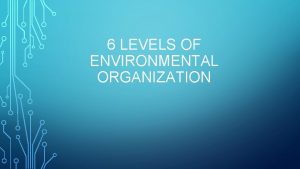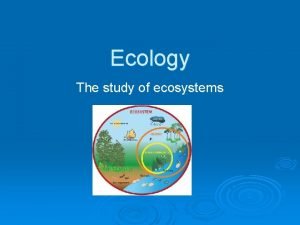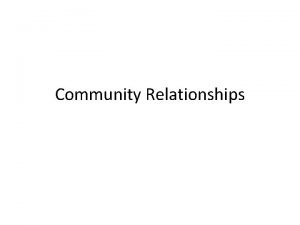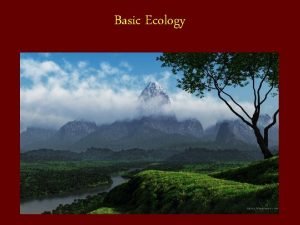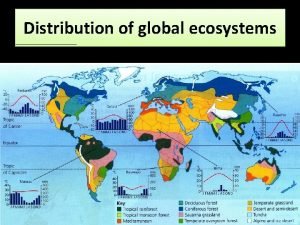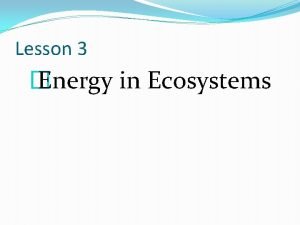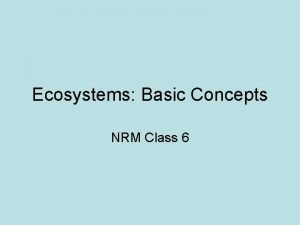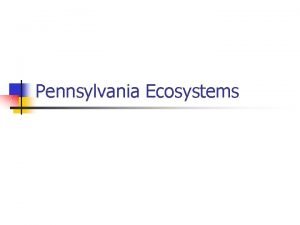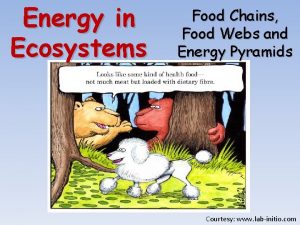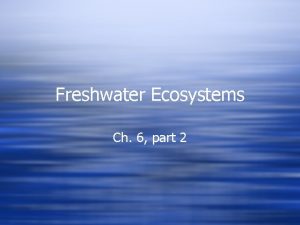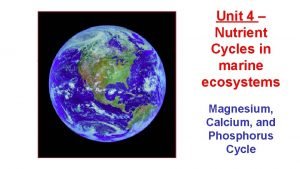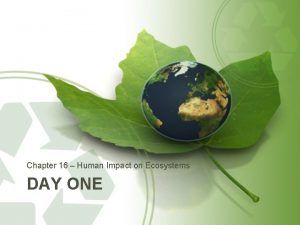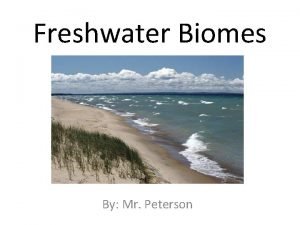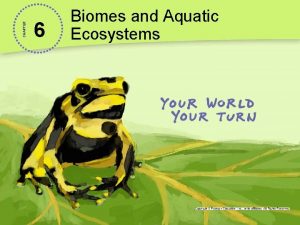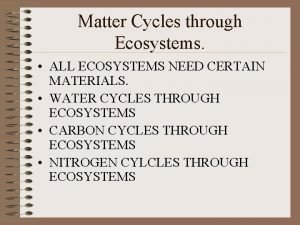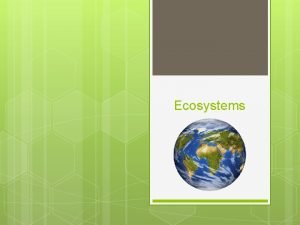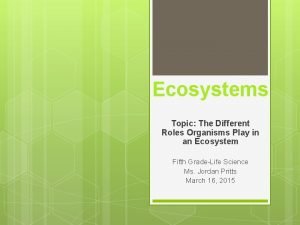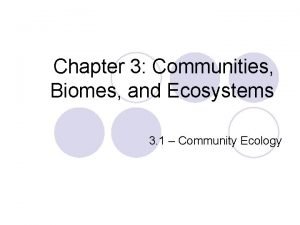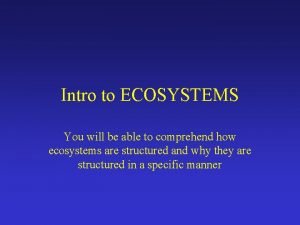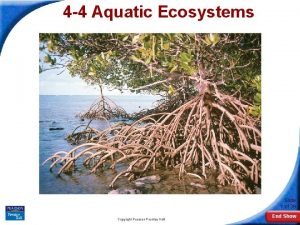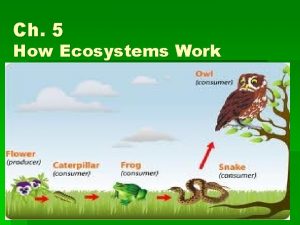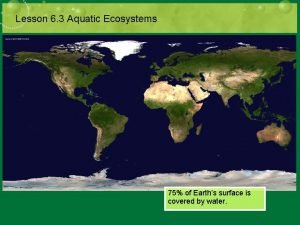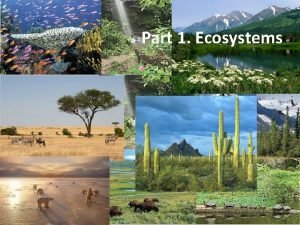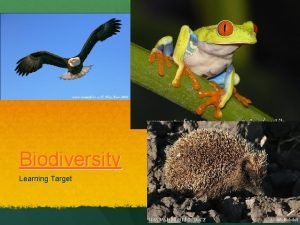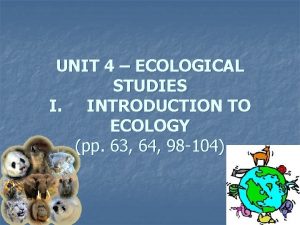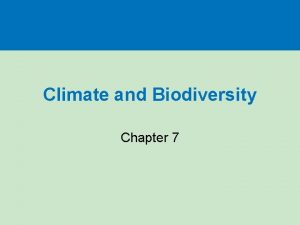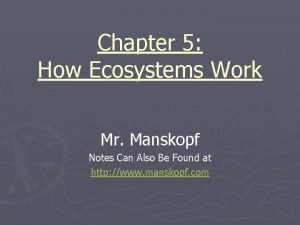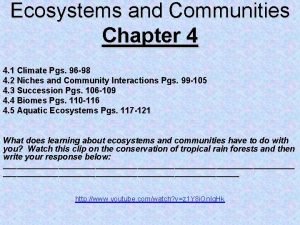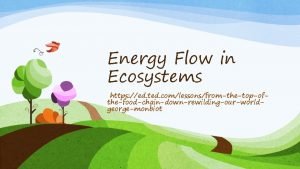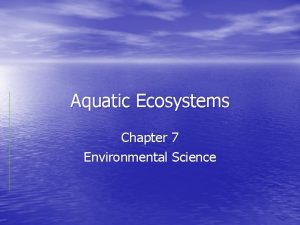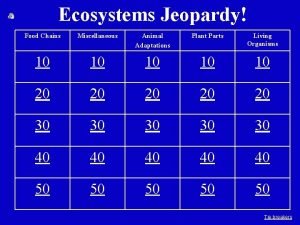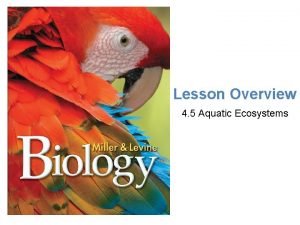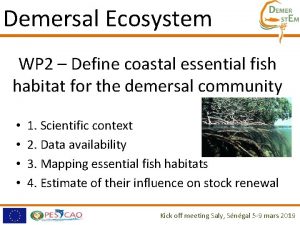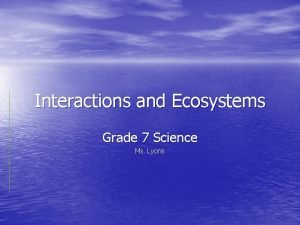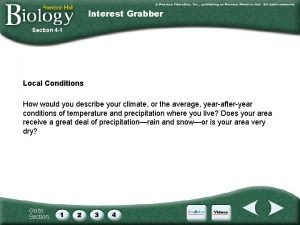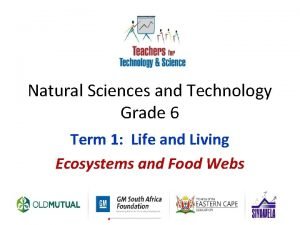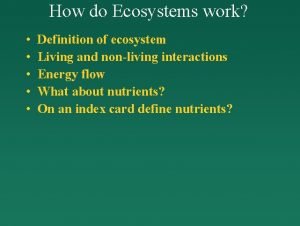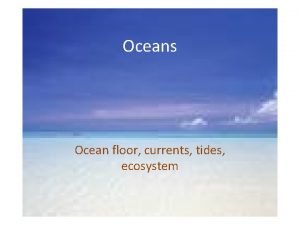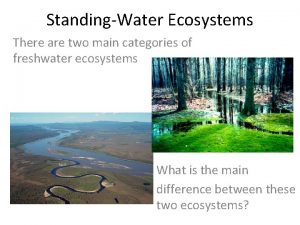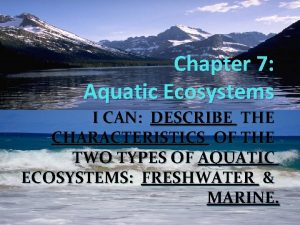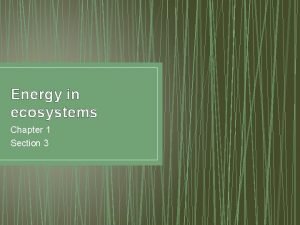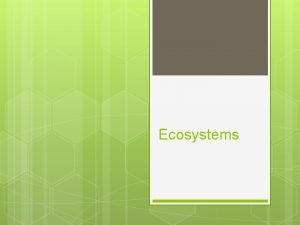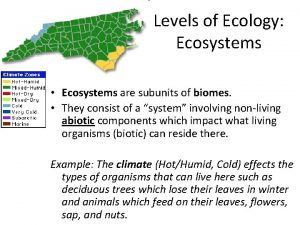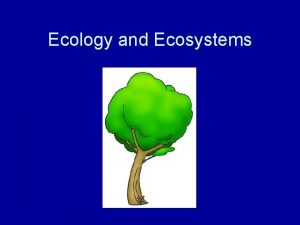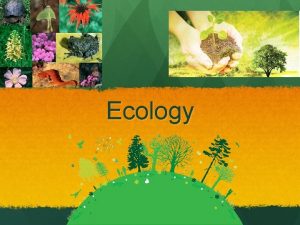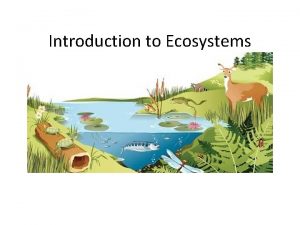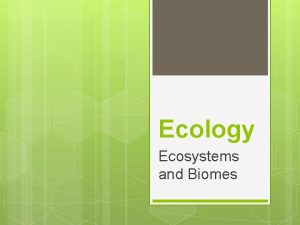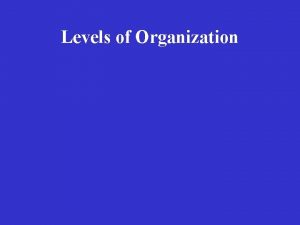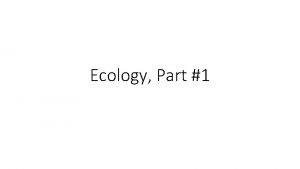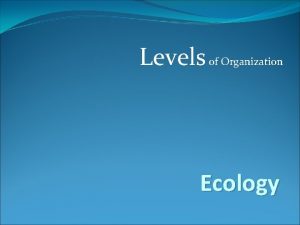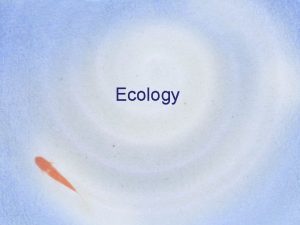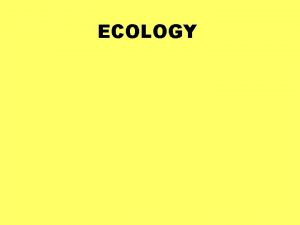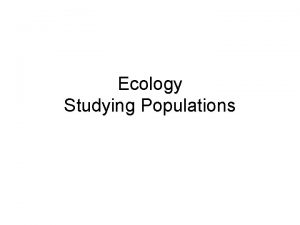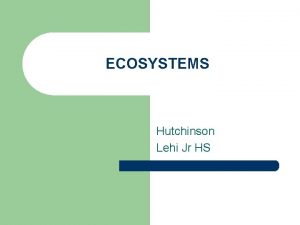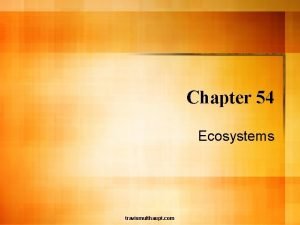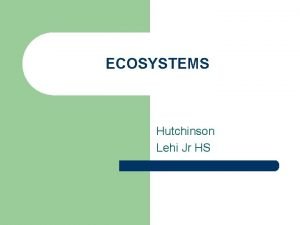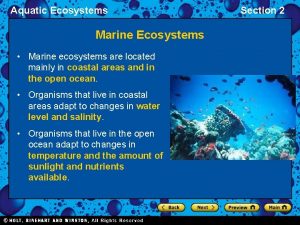Ecology Levels of Organization Levels of Organization Ecosystems
























































- Slides: 56

Ecology

Levels of Organization

Levels of Organization

Ecosystems

Example of some Local Ecosystems

Population A group of organisms of the same species living in the same area. Examples • The number of White Tail Deer living in Hampton. • The number of people living in New Hampshire

Limits on Population Size • Why don’t population sizes increase forever?


Community All populations in one area interacting Prod ucer s Con sum s r se o c De o p m ers

Community Relationships


Energy Flow


Energy Flow Autotrophs

Energy Flow Types of Heterotrophs

Food Chain The Steps are Called TROPHIC LEVELS

Food Web

Feeding Relationships


Ecological Pyramids

Roughly 10% of the energy is transferred 1 30 1, 100 15, 000 Leaves

Pyramids Continued

What Happens to the 90% that is NOT transferred to the next level?


2 How do plants get their food ? 74 kg soil 73. 943 kg soil In the 17 th Century, A Belgian physician, van Helmont, set up an experiment in which he planted a willow sapling in a weighed amount of soil. The soil was watered but nothing else was added. After 5 years, the tree had gained 74 kg in weight but the soil had lost only 57 g. van Helmont concluded that the tree had made 74 kg of new growth from water alone

3 van Helmont’s experiment was effective in showing that the plant’s food did not come from the soil. But he had overlooked the fact that air was available to the plant as well as water. Could it be that the plant made 174 kg of material from just air and water? This might seem unlikely but we now know that plants do indeed make their food from carbon dioxide from the air and water from the soil.

9 carbon dioxide water sunlight (energy) water

Photosynthesis

Photosynthesis

9 Energy It takes energy to make CO 2 combine with H 2 O This energy comes from sunlight The energy is absorbed and used by a pigment called chlorophyll

Leaf Anatomy

10 Chlorophyll The chlorophyll in the cells is packaged into tiny structures called chloroplasts The next slide shows a diagram of leaf cells with their chloroplasts

Plant Cell


Anatomy of a Leaf


What happens to the glucose? 15 The glucose made by the chloroplast is either (a) used to provide energy for the chemical processes in the cell ( by respiration) (b)turned into sucrose and transported to other parts of the plant or (c) turned into starch and stored in the cell as starch grains In darkness the starch is changed back into glucose and transported out of the cell

23 TO SUM UP Plants combine carbon dioxide from the air, and water from the soil to make glucose. The energy needed for this process comes from sunlight The sunlight is absorbed by chlorophyll contained in the chloroplasts of the leaf. The glucose can be used for energy or to make other substances. To make other substances, the glucose must be combined with other chemical elements such as nitrogen and potassium. These chemical elements are present in the soil

Respiration = use of oxygen to burn food for energy

Respiration Chemical Formula It’s the Reverse of Photosynthesis

REVIEW Animals get their food by eating plants, or other animals Carnivores eat animals Herbivores eat plants Plants make their own food They combine carbon dioxide from the air with water and dissolved salts from the soil Plants do NOT get their food from the soil The process by which plants make food is called PHOTOSYNTHESIS 4

Question 1 For a plant to make glucose it needs (a) CO 2 and H 2 O (b) CO 2, H 2 O and sunlight (c) CO 2, H 2 O, sunlight and chlorophyll (d) CO 2, H 2 O, sunlight, chlorophyll and nitrates 25

26 Question 2 A by-product of photosynthesis is (a) Water vapour (b) Oxygen (c) Carbon dioxide (d) Nitrogen

Question 3 The food made by photosynthesis is stored as the plant in the form of (a) Glucose (b) Sucrose (c) Starch (e) Cytoplasm 29

Cycles of Matter • Unlike the one-way flow of energy, matter is recycled within and between ecosystems. • These cycles are the water cycle, Nutrient Cycle, Carbon Cycle, nitrogen cycle and phosphorus cycle. • These cycles are important so that the matter can be re-used by living things.

Water Cycle

Oxygen/Carbon Cycle

Carbon Cycle



Nitrogen Cycle


The Nitrogen Cycle Nitrogen gas Plants Make Proteins with Nitrates (N 2) Animals Make Proteins by consuming Plant or other organisms Waste Soil Bacteria Nitrite (NO 2) Soil Bacteria Nitrate NO 3 Nitrate (NO 3)

Nitrogen Cycle FOOD contains PROTEIN Nitrogen is in the fish in the form of PROTEIN__ WASTE (NH 3) (NH 4+) NO 3 is absorbed by the plant roots and made into Nitrogen in the waste is in the form of _____________ that can be used in food AMMONIA NH 3 Uneaten food is decomposed into Ammonia (NH 3) by BACTERIA NO 3 is eaten “decomposed by a bac 3 erial called Ammonia is eaten “decomposed” by a bacteria called (NO 2) __NITROBACTER__ into _NITROSOMONAS Nitrite ____NITRATE, into NITRITE, NO 2 NO 3 ___

19 Nitrates are present in the soil, dissolved in water The plants take up nitrates in the soil water The nitrates are conducted through the roots to the stem and then to the leaves In the leaves, the nitrates and glucose are combined to make proteins This process is called assimilation

 Chapter 55 ecosystems and restoration ecology
Chapter 55 ecosystems and restoration ecology Chapter 55 ecosystems and restoration ecology
Chapter 55 ecosystems and restoration ecology 5 levels of environmental organization
5 levels of environmental organization Levels of organization in ecology
Levels of organization in ecology Symbiotic relationship
Symbiotic relationship Four levels of ecology
Four levels of ecology Costa's level of thinking avid
Costa's level of thinking avid Which of the following tells you population density
Which of the following tells you population density Distribution of ecosystems
Distribution of ecosystems Chapter 4 lesson 2 energy flow in ecosystems answer key
Chapter 4 lesson 2 energy flow in ecosystems answer key Chapter 7 aquatic ecosystems test answers
Chapter 7 aquatic ecosystems test answers Provides practically all the energy for ecosystems
Provides practically all the energy for ecosystems Pennsylvania ecosystems
Pennsylvania ecosystems Lab food chains and energy in ecosystems
Lab food chains and energy in ecosystems Human impact on freshwater ecosystems
Human impact on freshwater ecosystems What factors describe aquatic ecosystems
What factors describe aquatic ecosystems Magnesium cycle in marine ecosystem
Magnesium cycle in marine ecosystem Chapter 16: human impact on ecosystems answer key
Chapter 16: human impact on ecosystems answer key Freshwater biomes facts
Freshwater biomes facts 6 biomes and aquatic ecosystems answers
6 biomes and aquatic ecosystems answers Matter cycling in ecosystems
Matter cycling in ecosystems Biome energy
Biome energy Acquired traits examples in humans
Acquired traits examples in humans Ecosystems jeopardy 5th grade
Ecosystems jeopardy 5th grade Orderly natural changes and species replacements
Orderly natural changes and species replacements Intro to ecosystems
Intro to ecosystems 4-4 aquatic ecosystems
4-4 aquatic ecosystems How ecosystems work
How ecosystems work Lesson 3: aquatic ecosystems
Lesson 3: aquatic ecosystems Objective of ecosystem
Objective of ecosystem Why is biodiversity important
Why is biodiversity important Ecosystems interactions
Ecosystems interactions Human impact on terrestrial ecosystems
Human impact on terrestrial ecosystems Interactions within ecosystems grade 7
Interactions within ecosystems grade 7 Chapter 5 how ecosystems work study guide
Chapter 5 how ecosystems work study guide Chapter 4 ecosystems and communities
Chapter 4 ecosystems and communities How does energy move through most ecosystems on earth
How does energy move through most ecosystems on earth Ted ed ecosystems
Ted ed ecosystems Limestone ridges built by tiny animals
Limestone ridges built by tiny animals Chapter 42 ecosystems and energy
Chapter 42 ecosystems and energy Lesson outline lesson 2 aquatic ecosystems answer key
Lesson outline lesson 2 aquatic ecosystems answer key Def of secondary succession
Def of secondary succession Main ecosystems
Main ecosystems Food chain jeopardy
Food chain jeopardy Photic and aphotic zones
Photic and aphotic zones Competition in ecosystems
Competition in ecosystems Define demersal
Define demersal 4 food chains
4 food chains Types of producers in science
Types of producers in science Section 4-4 aquatic ecosystems
Section 4-4 aquatic ecosystems Aquatic vs terrestrial
Aquatic vs terrestrial Grade 6 natural science term 2
Grade 6 natural science term 2 How do ecosystems work
How do ecosystems work Most amazing ecosystems
Most amazing ecosystems What are the two main categories of ecosystems
What are the two main categories of ecosystems Marine ecosystem webquest
Marine ecosystem webquest Section 3 energy in ecosystems
Section 3 energy in ecosystems


